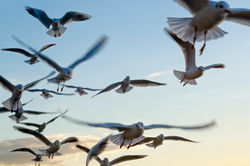NEW MEXICO BOOTHEEL SEPT. 9-12, 2021
- Bill West
- Oct 6, 2021
- 3 min read
Usually, WingsWest Birding tours are on the cushy side so doing an all camping trip was new territory. And the territory we visited was indeed remote-the New Mexico bootheel. Situated in extreme southwest NM, the bootheel terrain is the classic basin and range with isolated "sky islands" surrounded by high altitude grasslands or stretches of Chihuahuan desert. Our itinerary had two major destinations, Clanton Canyon in the Peloncillo Mts. and Guadalupe Canyon on the Mexican border.
We arrived in the area from the village of Animas, located in the rather long valley of the same name. Our first birding objective was to search for Botteri's Sparrow, a largely Mexican species at the northeast edge of its range. Thinking we might be too late in the season, we were delighted to have one of the sparrows respond immediately to playback from its preferred habitat of sacaton grass. Heading further south in the valley, we noticed an out of place Great Blue Heron on the side of the road. Turns out that summer rains had collected in a low spot and had attracted not only a flock of Yellow-headed Blackbirds but a seemingly out of place cluster of 5 southbound Solitary Sandpipers, oblivious to their own name. We continued on to Clanton Canyon, set up tents in the Chihuahuan Pine/oak setting and were serenaded after sunset by both Western and Whiskered Screech Owls and multiple poorwills.
Staying in Clanton for day 2, we encountered the expected residents including Mexican Jay, Bridled Titmouse, Hutton's Vireo, and Arizona Woodpecker. Insectivores had largely departed for points south but stragglers included Hepatic Tanager and Black-throated Gray and Grace's Warblers. An unexpected treat in the late pm was a first year Northern Goshawk flashing by us twice. The dusk night bird chorus was similar to the previous evening with 2 N. Pygmy Owls joining in.
Next morning we were rolling by 3:45 am for our descent to Guadalupe Canyon. Being over 1,000' lower than Clanton, we entered a very different deciduous riparian world highlighted by Arizona Sycamore, Arizona Black Walnut, and cottonwoods (and running water in the creek!). As we hiked toward the NM portion of the canyon, we were greeted by a rattlesnake we heard loudly to the side of the road (but never saw) and then stumbled upon (almost literally) what we were later told was a Sonoran Coral Snake-deadly poisonous but weak jawed and, thus, unable to bite through human footwear. Lovely creature. After enough light arrived for us to bird we began by crossing paths with 2 late Violet-crowned Hummingbirds just over the NM/AZ line. Soon we realized there was a migration event going on in the canyon with Western Tanagers and Nashville Warblers everywhere. Canyon regulars such as Gila Woodpecker, Bell's Vireo, Black-tailed Gnatcatcher, Gray Hawk, and Broad-billed Hummingbird escorted us along our way. We persevered the full 5 plus mile hike to near the Hadley Ranch house and were rewarded with great looks at both Rufous-winged Sparrow and a late Thick-billed Kingbird. Our birding good fortune was followed by logistical luck as a maintenance truck from the ranch gave us a ride out in the mid day heat for the last 2 miles of the road.
Our last day began in Cave Creek Canyon outside Portal, AZ. As we had a 7 hour drive ahead of us, we departed AZ early to do some final birding on the NM side of things. Along Cienega Ranch Road north of Rodeo, we found some standing water, presumably in old gravel pits. Migrants that had found the spot included Lazuli Buntings, Lucy's Warblers, Vermilion Flycatcher, and yet another Solitary Sandpiper (living up to its moniker). We moved on to the NM portion of San Simon cienega where dead cottonwoods stood as a reminder of an area that once had water close to the surface but had basically gone dry as agriculture lower down in the AZ portion of the valley had spread. But some bird species still found where we stood to their liking. Notably Abert's Towhee which gave us brief looks before blending back into the shrubbery. Our final foray of the trip was a swing through Cotton City, back up in the north end of the Animas Valley. I was hoping for a Harris' Hawk encounter but, instead, we started to see a different raptor. Swainson's Hawks were on about every 4th power pole but the real show was in the sky. We watched several kettles of Swainson's circling on the late morning thermals. We conservatively estimated 75 individuals but I suspect there were more. We wished them good fortune on their flights to either west Mexico or Argentina as we headed back north on our relatively insignificant journey.




Comments